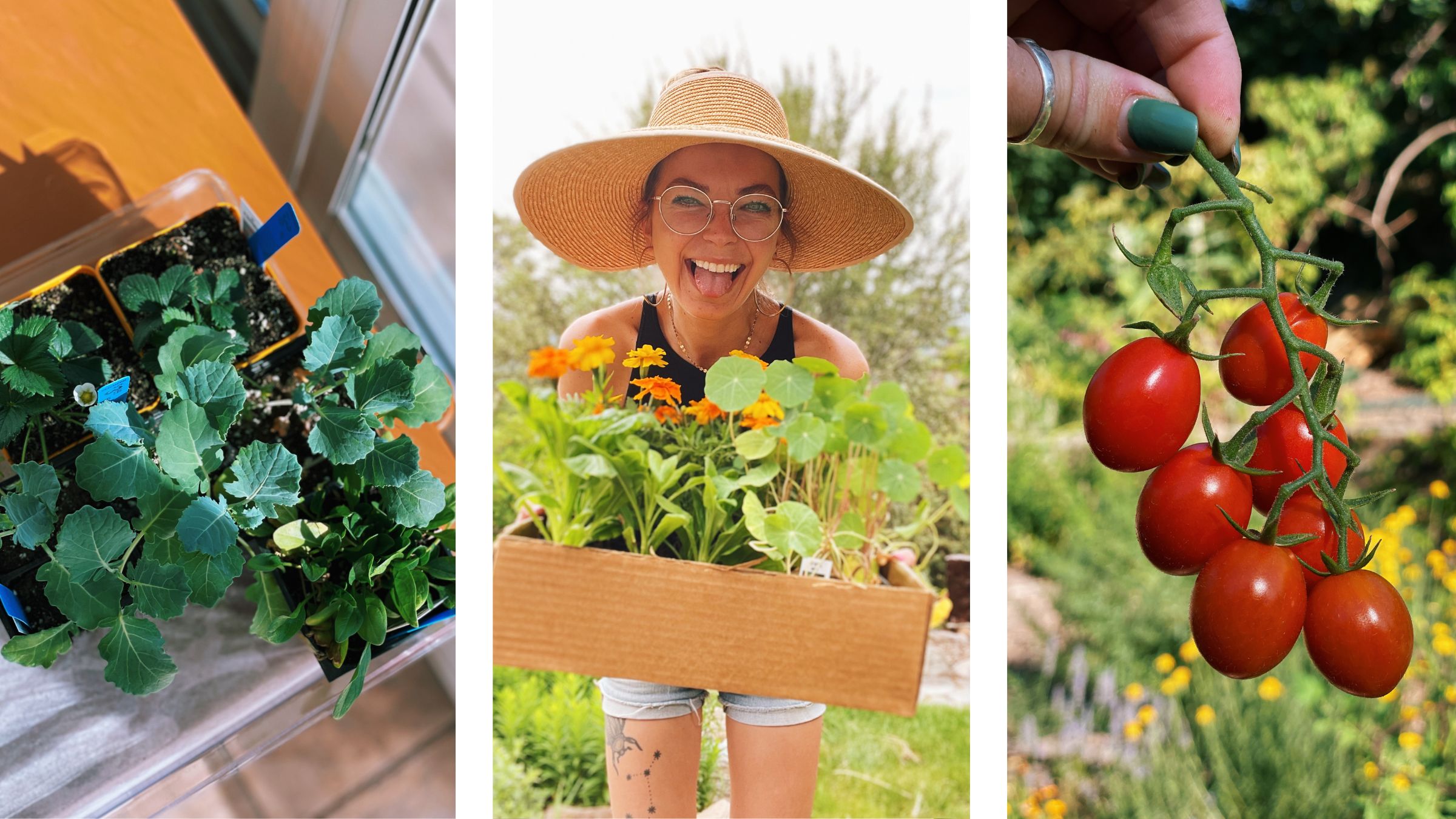Is your backyard littered with dead plants and forgotten dreams? Do you couch rot while scrolling videos from Ballerina Farm? Are you a millennial grappling with the inevitable transition from van-life dirtbag to homeowner in the ’burbs? You need a little low-key, lazy gardening in your life.
USDA Zones 101
A quick education on your local growing conditions is the backbone of lazy gardening. First, you need to figure out what zone you live in—as in . This map calculates each region’s average annual extreme low winter temperatures and sets the baseline for understanding what types of plants grow best in your area.
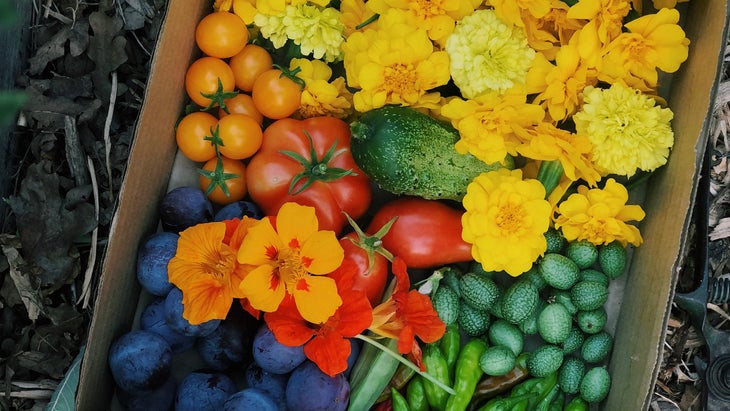
Identifying your hardiness zone is as easy as entering your zip code, and it’s the most important guiding information for gardening. After you know your zone, check plant tags at your local nursery or big-box store to make sure what you buy has a good shot at growing where you live. If you know any gardeners, ask them for their best crop recommendations. Every region has different sun, soil, water, and growing conditions, so your community can offer invaluable guidance. Where I live on a��homestead in Salt Lake City, Utah, blackberries and raspberries grow like weeds, but due to the low acidity in our dirt, blueberries don’t stand a chance unless you become a hardcore soil chemistry hobbyist. So, as a fellow lazy gardener, I grow blackberries and raspberries.
Seeds Versus Seedlings
Forget starting seeds, buy the seedlings. Listen, you don’t need to grow your tomato from seed in order to boast the joys of homegrown tomatoes—you can buy already thriving plants and just stick them right in the ground.
Growing from seeds may seem like a cheaper path, but when you factor in soil and supplies, the meticulous daily watering schedule, and figuring out supplemental lighting and a dedicated space, and managing the timing of it all, it might be easier and more affordable to just bypass straight to baby plants.��For perspective, I begin my seed starting in early March, and my plants don’t go into the ground until mid-May, after nearly three months of daily care for hundreds of little needy seedlings��living in my basement. That is the antithesis of lazy gardening.
Plus, let’s do some quick math: a packet of honey drop cherry tomato seeds might run you $2.99 (just seeds, not including lights, water, soil, container), while a single honey drop cherry tomato seedling from the Wasatch Community Gardens plant sale cost me $4.00.
Spare yourself the seasonal part-time job and check out local seedling sales in the spring, or visit local garden centers any time of the season. My go-to in Salt Lake City is the annual Wasatch Community Gardens (WGC) plant sale. WCG Executive Director Georgina Griffith-Yates recommends seedlings over seed starting for new or low-key gardeners.
“Our Plant Sale sees anywhere from 3,500 to 5,000 community members who want to support local programming and enjoy low cost, USDA-certified organic plant babies—as we lovingly call them,” said Griffith-Yates when I asked her to explain why the plant sale is so important. “WCG’s Job Training Program offers women facing homelessness the opportunity to work a paid position on WCG’s beautiful urban farm in Salt Lake while working toward stable housing and employment. Each spring these women, along with staff and volunteers, grow over 40,000 veggie, fruit, and herb seedlings that we sell at our annual Spring Plant Sale, so you can skip seed starting and dive straight into garden season.”
But even if you don’t live in the Salt Lake area, there’s likely a great place to buy seedlings in your area. As a starting point, check with your local nursery or farmer’s market.
Easy Plants for Beginners and Lazy Gardeners
No matter what you’re growing, healthy soil is the key to happy, low maintenance plants. Grab a few bags of gardening soil to add to your plant’s new home, and for bonus points you can bury your seedlings with a handful of earthworm castings tossed in for extra nutrients. If you add mulch around your garden, it will help retain moisture.
Here are my favorite easy-to-grow plants that I always keep in my garden.
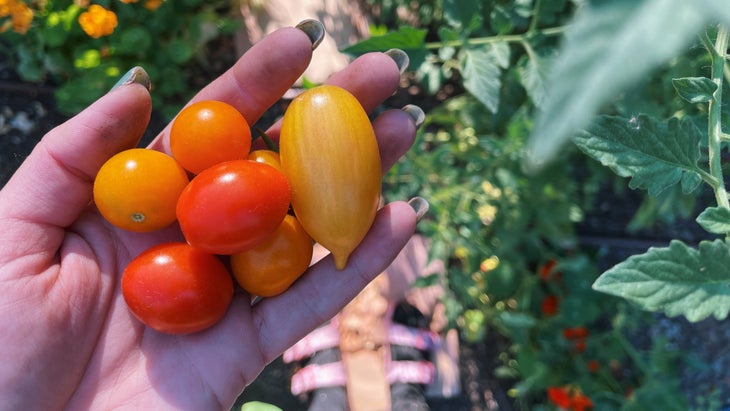
Annuals
Annuals are seasonal plants that you start from scratch every spring. They die every winter after the first frost. One handy trick I use with annuals is planting ones that will reseed themselves. I have many patches of my property that are technically annuals, but reappear every year without additional work from me. My favorites include calendula, poppies, nasturtium, chard, and delphinium flowers. How do I do it? I simply leave the plants alone to reseed themselves, letting them fully mature and then die, resulting in less garden clean-up.
Tomatoes
Every gardener needs a tomato plant, and cherry varieties are the best for lazy gardeners. They’re easy to grow, and they produce prolifically. For maximum tomato with minimum effort, check out Supersweet 100, Sungolds, and Gold Nugget varieties. Avoid heirloom tomatoes—they’re needier.
Water: One to two inches per week
Sun: Full sun, at least six to eight hours per day
Pro tip: Tomatoes do not like wet leaves, so be sure to only water at the base of the plant.
Summer Squash
Squash (think: zucchini) vines can grow huge and produce more vegetables than you’ll know what to do with, which definitely results in a satisfying grow for lackadaisical gardeners.
Water: One to two inches per week
Sun: Full sun, at least six to eight hours per day
Green Beans
There are two types of green beans: push and pole beans. Both are easy to grow, though pole beans prefer a trellis, stake, or cage to vine up. If you’re on a budget and don’t want to buy more garden supplies, any tall sturdy object will do. (I’ve used old broom sticks as trellises!) Green beans germinate and mature very quickly, making them an excellent choice to experiment with direct seed starting outside.
Water: One to two inches per week
Sun: Full sun, at least six to eight hours per day
Cucumbers
You should always grow food you like to eat, and there are few things more pleasant on a hot summer day than a crisp cucumber. Like green beans, members of the cucurbit family (related to squash) love a trellis, stake, or something to crawl up.
Water: One to two inches per week
Sun: Full sun, at least six to eight hours per day
Pro tip: Harvest cucumber when they’re mature but small and tender. Overgrown cucumbers can taste very bitter.
Radish
Few edibles mature as quickly as radishes, and a faster turnaround lessens the time lazy gardeners have to mess things up and accidentally murder a plant.
Water: One to two inches per week
Sun: Full sun, at least six to eight hours per day
Garlic
Plant bulbs in autumn, and forget about them. Harvest your haul in early summer, and hang the garlic in your garage for two weeks. Just like that, you’ve got cured garlic to store and eat for months. This year I was eating my own garlic from July until May.
Water: One inch per week
Sun: Full sun, at least six hours per day
Pro tip: In the spring, garlic plants produce a flowering mechanism called a scape. To ensure the biggest garlic head possible, clip the scapes before they fully develop so the plant sends all its energy downward. Bonus: there are tons of out there to try.
Chard and Other Greens
Much like radishes, chard and other greens tend to reach harvest time quickly due to fast maturity. I find growing lettuce greens to be tricky in the heat of Utah, but swiss chard is a hardy green I use in nearly every dish. It tolerates heat better than tender lettuces, and during winter I just throw a frost cloth over the bed and continue to harvest all year long.
Water: One to two inches per week
Sun: Six to eight hours of sun per day (but too much direct sun and heat will burn it)
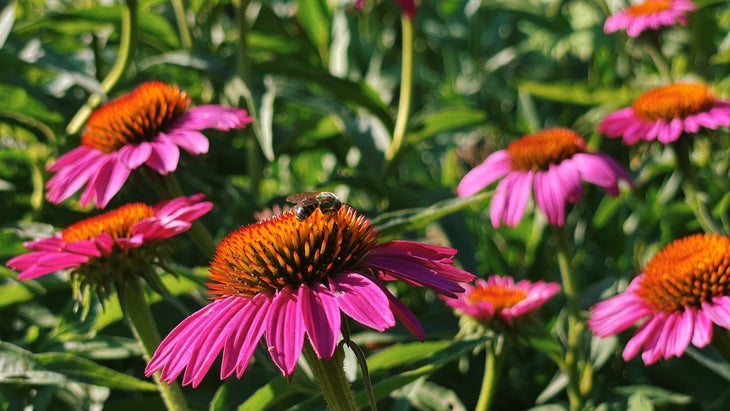
Perennials
As the opposite of annuals, plants classified as perennials do not die in the winter, making them a great choice for lazy gardening. Plant once, enjoy forever. Perennials need good watering initially to get established, but can be quite hardy against drought conditions—and a little neglect—once settled they’re into the soil. My favorite easy perennials include some of the following.
- Black-eyed Susan: You’ll recognize this classic perennial for its cheerful yellow flowers.
- Lavender: I love a useful perennial. I incorporate lavender into simple syrup and baked goods. Plus, pollinators love it.
- Hummingbird mint: This whimsical flower smells delicious and is a favorite of its namesake, hummingbirds.
- Yarrow: Revered for its medicinal properties, yarrow also has brightly colored flowers that make for excellent dried arrangements.
- Coneflower or echinacea: These big, gorgeous flowers are long lasting and have ancient medicinal uses.
- Blanket flowers: Blanket flowers come in a variety of colors and hue combinations. Plant a few different types to add visual interest to your landscaping.
Always read the tags when you buy a new plant, but the general rule of thumb for perennials is consistent: after planting, water deeply two to three times per week to a depth of one inch for a few weeks until established. Then reduce your watering to once a week to a depth of one inch once the plant is happy in its new home.
Sun matters, too. Before committing to planting, keep an eye on your yard throughout the day to note the sunlight. Similar to many annuals, full-sun is a common requirement for perennials. Make sure you’re selecting the right seedlings and the right place to plant them. The perfect combination of water and sunlight is vital for happy plants.
When shopping for perennials, it is key to keep your hardiness zone in mind, as well as what plants are native to your area. Choosing plants that are naturally found where you live will set you up for success. Plus, the perennials on the list above are all excellent pollinator plants that will support bees, butterflies, birds, and beneficial bugs.
A Word of Caution About Extremely Hardy Plants
There are a few plants that I would classify as radically abundant; they’ll grow great, sometime to the point of getting out of control. Proceed wisely. For example, Russian sage is a perennial with big purple flowering stems reminiscent of lavender, and it makes a great landscaping option for lazy gardeners who want to fill a big space. They’re also easy to prune, because they’ll take a sloppy whacking and bounce right back. My garden is also exploding with oregano, mint, catnip and wild garlic—none of which I planted or specifically watered. Especially if you plant mint, I would suggest keeping it in a container so it doesn’t take over.
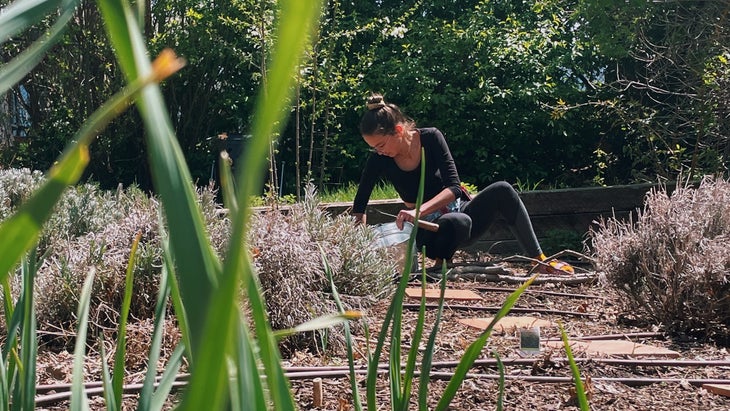
Easy Tips on Basic Upkeep
Drip irrigation is worth the cost. If you have the resources, drip irrigation will change everything for a lazy gardener. My main garden is rarely watered by me; I have a multi-zone automatic watering system that does it for me. It is not only scheduled to regularly water based on each zone’s needs, but it also integrates with the local forecast to reduce watering when there’s a lot of rain. It’s more efficient (both for the planet and your wallet), and it eliminates one more barrier to make growing your own food as easy as possible. Drip irrigation is an upfront investment and a bit of hands-on labor, or you can just hire someone to install a simple system for you.
Plant what you’ll use. An important consideration for any gardener, but especially those of us with unmedicated ADHD, is to focus on planting food you’ll actually eat. I spent too many seasons trying to grow flashy and cool ground cherries, only to realize I don’t really eat those often. And when you’re not excited to eat something in your garden, you’re not going to be motivated to keep it alive.
Don’t freak out if plants die. If you kill a plant or two or ten, it isn’t totally your fault. It’s all a learning process, sometimes things are out of your control, and hey, the plant should have tried harder. Plus, who doesn’t love an excuse to go get a little iced coffee and back to the garden store?
Consistency is key. Basic gardening doesn’t require constant hands-on work, but it does rely on consistency. If you, like me, struggle with time management, I suggest setting up a dedicated calendar just for garden tasks. I set recurring events for things like fertilizing, pruning, deep watering, even harvesting. Spending ten minutes in the garden every other morning will become an easy habit. In fact, “I’m going down to work in the garden!” has become my secret lazy-girl battlecry. Nothing sounds more productive to my husband than “I’ve been out in the garden for four hours.” What he doesn’t need to know is I spent about ten minutes pulling weeds and three hours sitting in the lavender bush watching the bees.
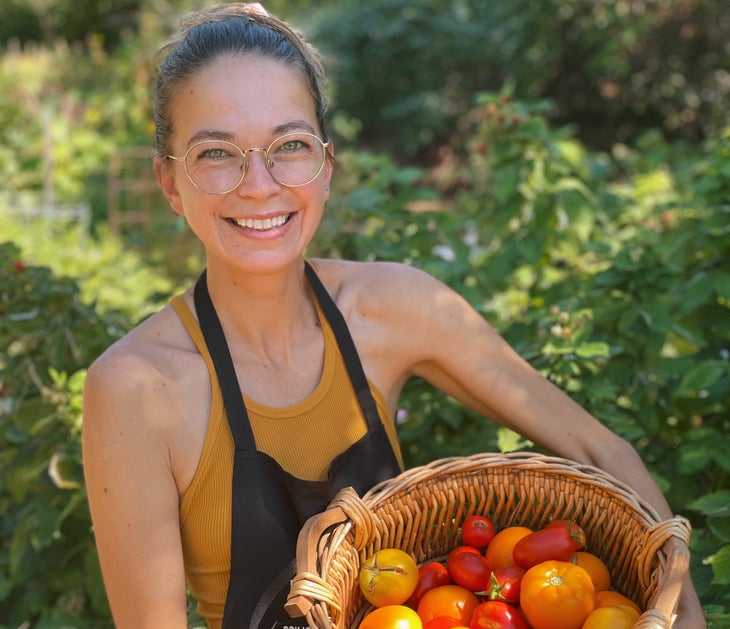
Katie Boué spends most of her time tending to her half-acre homestead in Salt Lake City, Utah. When she’s not in her garden or chicken coop, she’s exploring outdoors with her dog Spaghetti or working on local advocacy projects. She became a certified Master Gardener in 2023 and believes growing your own tomatoes is the ultimate gateway to get folks involved with advocating for the world around us. Her debut book, , is available anywhere books are sold.


